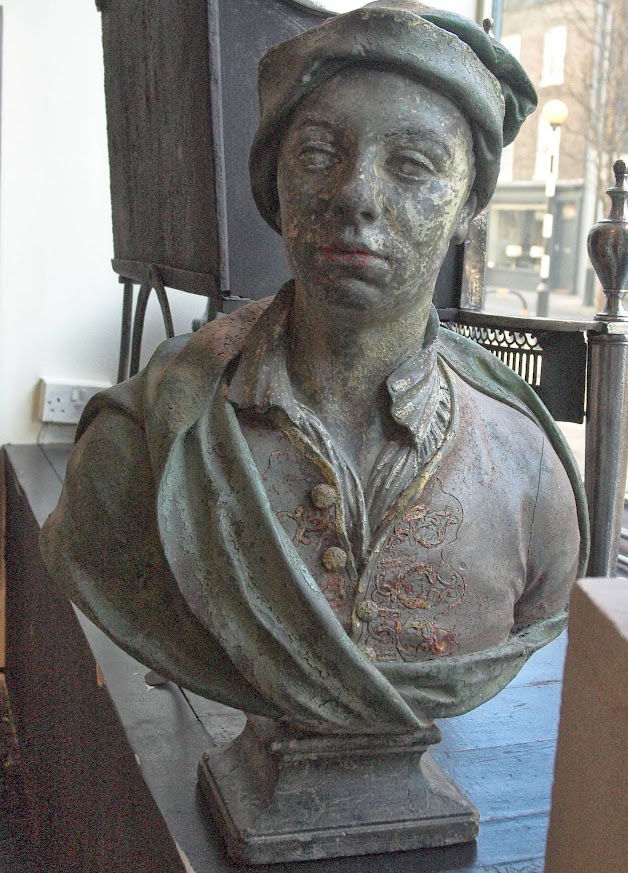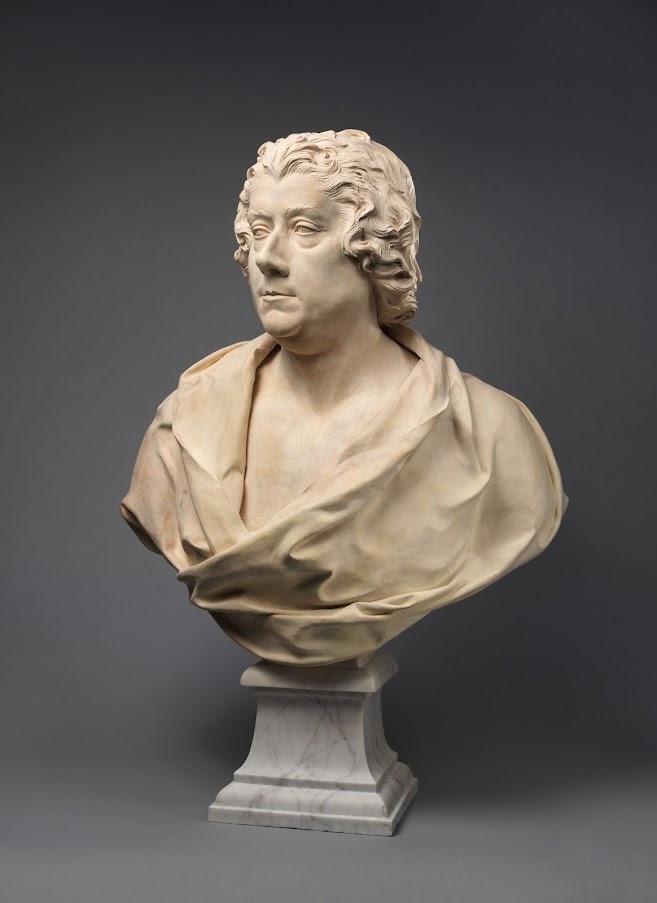______________________________________
When I first wrote this blog entry I believed that the lead bust was of Senesino but since the acquisition of the terracotta bust of Senesino by the Metropolitan Museum, New York with an excellent provenance I have had to drastically alter my opinion.
I was wrong.
The very unusual physiognomy of this bust has bothered me for some time; there is an almost girlishness, fresh facedness about him.
Certainly
the lack of testosterone which led to a female type distribution of
fat on the body and lack of beard, aided the youthful castrati in
taking on female rolls.
This
bust also shows a distinct lack of Adams apple, the growth of which
is also inhibited by the lack of testosterone in the castrato.
See.
The
Eroticism of Emasculation: Confronting the Baroque Body of the
Castrato
Roger
Freitas
Journal
of Musicology,
Spring
2003, Vol. 20, No. 2, Pages 196–249.
"My
central argument in this study is that, on the Italian baroque stage,
the castrato represented a theatrical imitation of this erotically charged
boy. Just as stage sets might exaggerate an architectural vista or costumes
aggrandize Roman armour, so too did the castrato magnify the familiar
youth. He inhabited the same intermediate sexual zone as the boy,
sharing the erotic mixture of masculine and feminine qualities.
Support
for this assertion comes from many quarters. Physically, of course,
a castrato simply retained many of his boyish features well into the years of adulthood: Although he might grow in height
(sometimes to
unusual proportions), he retained his high voice, lack of beard, and soft
body.
The few known portraits of castrati also suggest that they
retained their
boyishly round faces and full cheeks, probably a consequence of
the eunuchoid fat patterning discussed below .That this boyish
appearance tended to affect the contemporary conception of
these individuals is suggested by the frequent use, well
into adulthood, of diminutive nicknames for them, such as Nicolino, Senesino,
Giuseppino, Marianino, and Pauluccio”
Laura
E.DeMarco, "The Fact of the Castrato and the Myth of the
Countertenor," Muszcal Quarter4 86 (2002): 1 74-85.
John
Rosselli, "Castrato," in Grove Dictionary of Music and
Musicians, 2nd ed.
(New
York: Grove's Dictionaries, 2001) (Emphasis mine).
See
also John Rosselli's central article, "The Castrati as a
Professional Group and a Social Phenomenon, i 55-1850,''
Acta
Musicologica 60 (1988): 143-79,
Beth
Kowaleski-Wallace, "Shunning the Bearded Kiss: Castrati and the
Definition of
Female Sexuality," Prose Studies 15( 1992): 154.
Angus
Heriot’s The Castrati in Opera (1975);
Richard
Somerset-Ward. Angels and Monsters: Male and Female Sopranos in
the Story of Opera, 2004.
It
is my belief that the sculptor has tilted the head forward in order
to minimise the effect of his upturned pug like nose obvious in his
portraits, Roubiliac was not known for flattering his sitters by
romanticising their appearance.
A
bust of Senesino was completed by Roubiliac by 1736. I understand
that there is a pocketbook belonging to Elizabetta Avanzatti (an
Italian historian and distant relative of Senesino and who resides in
the Palazzo Bernard Avanzatti in Sienna) this pocket book was kept by Senesino
and mentions his sitting for Roubiliac in 1735.
For
Senesino see The Unpublished Senesino by Elisabetta Avanzatti in
Catalogue Handel and the Castrati -2006. Handel House, London.
It
seems that Senesino owned a marble bust of himself and requested
in his will that it be used as his funeral monument at Sienna. It has since disappeared, presumed destroyed in the Napoleonic Wars.
There is a
short poem by Lockman on Roubiliac and his bust of Senesino in the
London Daily Post and General Advertiser of 4 June 1736. I believe
this is probably the first mention of Roubiliac in the English press.
To
Mr ROUBILIAC on seeing a bust made by him of SENESINO by Mr LOCKMAN
When Senesino breathes in Vocal strains
We think Apollo’s left the aetherial plains
When we the Warbler view, by thee exprest
He seems as by the hand of nature drest
Thy art so happily eludes the eye
His voice such sweetness boasts, and swells so high,
That which best imitates, twill doubtful be
Thou Senesino or Apollo be.
Senesino
left England for Italy in 1736 never to return.
Farinelli
(Carlo Broschi born Jan. 24,
1705, Naples, died July 15, 1782, Bologna ),
the castrato opera singer left England 11 June 1737.
There
is a plaster bust of Farinelli at Real Academia de Bellas Artes de
San Fernando, Madrid, Spain.
This plaster bust is undated but must have been made
after his departure from England because
it shows him wearing the Cross of the Order of Calatrava awarded to
him in 1750.
Farinelli.
Note the prominent mole on his cheek.
George Vertue in 1738 mentions seeing a bust of him in Roubiliac's studio “a model in clay
the portrait of Faranelli the famous singer”.
John
Lockman mentions in one of four poems addressed to Roubiliac
in 1740 in A Miscellany of Poems (unpublished manuscript Bienecke
Library, Yale University.
"To my friend Mr Roubiliac, the sculptor,
after viewing his Rape of Lucretia & other models and another
upon a bust carved by him of Senesino".
Double Portrait after Grignion, Fitzwilliam Museum, Cambridge.
The
two portraits of Senesino most relevant to this post are -
An
engraved portrait of Senesino by Kirkall after Joseph Goupy of 1728.
_________________________
Senesino.
A
mezzotint by Joseph van Aken after Thomas Hudson of 1735.
The
painting has disappeared it was last mentioned in Hudson’s sale at
Christies of 26 Feb 1785, the pair to it of Farinelli, was engraved at
the same time. It is interesting to note that whilst Van Aken engraved both
Senesino and Farinelli – Roubiliac had sculpted their portraits at the same
time. Van Aken became known as a drapery painter for Hudson, Ramsay etc.
An earlier portrait of Senesino.
There
is a full length portrait of Senesino in Hungarian costume in the
Handel opera Rodelinda, of the mid 1720s by Vanderbank, (today in the
collection of the Earl of Malmsbury.)
There
is a depiction in Hogarth’s painting and print Marriage a la Mode
of an Opera singer which probably represents Senesino or an
archetypal Italian Castrato Opera singer (below).
Brief Biography of Senesino before coming to England.
Senesino
(Francesco
Bernardi)
(b.
31 October 1686, Siena; fl. 1707-40; d. Siena, 27 November
1758).
Castrato (range
g–g΄΄).
Bernardi,
nicknamed ‘Senesino’ was the son of a barber who destined both
him and his elder brother Giovan Carlo to the career of castrato
singers. After an early musical training as boy choristers at Siena
Cathedral, Giovan Carlo was castrated in 1696 and Francesco in 1699.
However, only Francesco achieved considerable acclaim and wealth. His
first documented operatic appearances were at Venice’s
Teatro Sant’ Angelo and in nearby Vicenza during the 1707-9 seasons
(in operas by Ruggieri, Albinoni and others). Over the next few years
he performed at Bologna, Genoa and Rome.
From October 1715 until January 1717, Senesino featured in six operas
at Naples,
including several by Alessandro
Scarlatti.
At this point in time, the Bolognese impresario Francesco Zambeccari
affected to find him incompetent in the recitatives and a poor actor.
In September 1717, Senesino was engaged for the court opera at
Dresden
on a lucrative salary and performed in three operas by Antonio Lotti,
with whom he had worked previously in Venice. In May 1719 Handel
received specific instructions from the directors of the Royal
Academy of Music
to ‘engage Senezino as soon as possible’ (Deutsch,
90), and visited Dresden that summer, where he probably heard the
singer perform in Lotti’s Teofane.

The Figure seated on the left is believed to represent Senesino - note the turned up nose -
The Toilette from the set of paintings Marriage a la Mode by William Hogarth.
National Gallery. London.
................................
Senesino.
Roubiliac
Metropolitan Museum, New York.









.jpg)














_MET_SF2016_47_img4.jpg)
_MET_SF2016_47_img2.jpg)
No comments:
Post a Comment